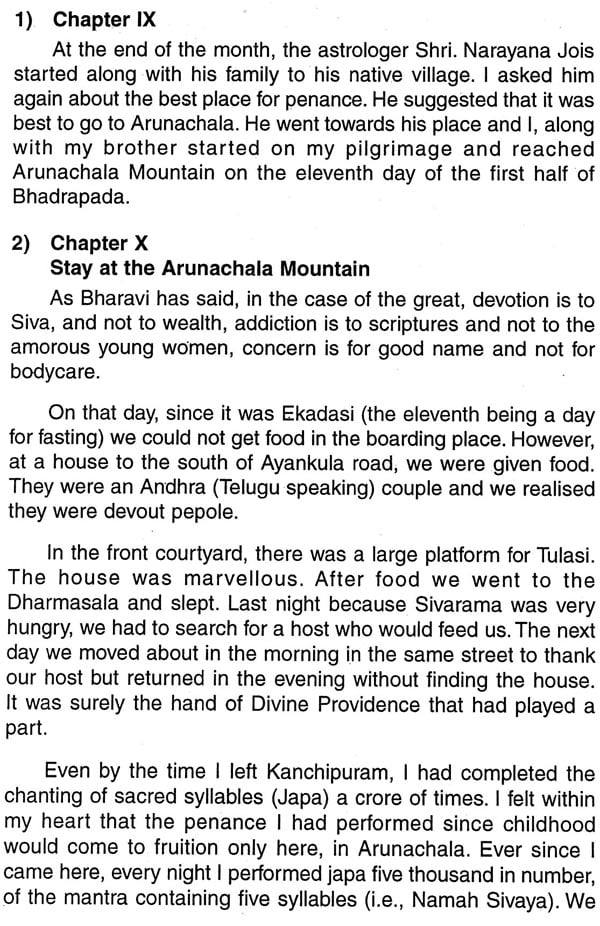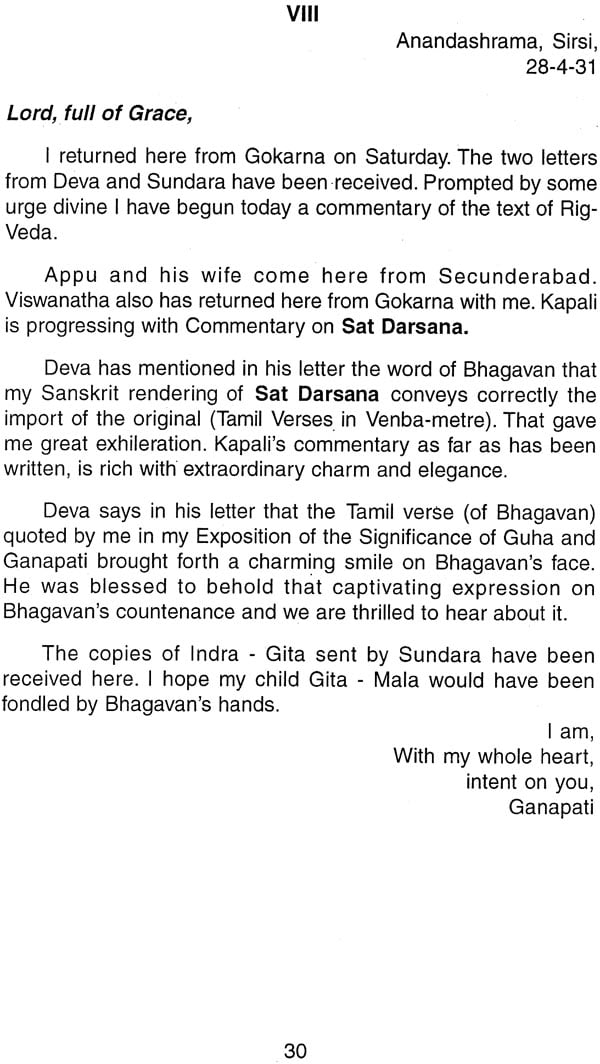
The Guru and The Disciple (Bhagavan Ramana and Ganapati Muni)
Book Specification
| Item Code: | NAR767 |
| Author: | Dr. S. Ramaswamy and A. R. Natarajan |
| Publisher: | Ramana Maharshi Center for Learning. Bangalore |
| Language: | English |
| Edition: | 2002 |
| ISBN: | 8185378703 |
| Pages: | 54 |
| Cover: | PAPERBACK |
| Other Details | 8.50 X 5.50 inch |
| Weight | 90 gm |
Book Description
The first person to whom Bhagavan Ramana gave instruction orally on his path of self enquiry for Self-knowledge was Ganapati Muni. Ramana was steadily abiding in the natural state of bliss after his enlightenment on the 17the of July 1896. Ganapati Muni had been performing penance in various sacred places but has not obtained its fruits because of the lack of a Sadguru’s grace. This was fulfilled when he surrendered wholeheartedly to Sri Ramana on the 18th of November 1907.
The Muni rechristened his guru, in whom he recognised the universal guru as Bhagavan Ramana Maharshi, the name by which he has been known since.
The relationship between a guru and a disciple has its own fascination. Here the beauty is heightened. Ramana’s way of guidance is unique as it brings one’s focus back to self-enquiry and surrencder. The Muni, being himself steeped in penance, was a disciple worthy of such a guru.
The beautiful story of their relationship comes out in two Sanskrit works ‘Vasistha Vaibhavam’ by Kapali Sastri, and "letters’ of the Muni to Sri Ramana from Sirsi. The purpose of this book is to make available a fresh translation so that all could share the relationship between an ideal guru and an extraordinarily endowed disciple.
The translation is by Dr. S. Ramaswamy former editor of the magazine ‘Tattvaloka’ and former Reader of English, Bangalore University. He is a profound scholar works.
The introduction is by Sri. A. R. Natarajan, author of several books on Sri Ramana Maharshi’s life and teachings.
It was Monday, the 18th of November 1907, Kartiga Shukla Chaturdasi. There were 'people, people everywhere'. Devotees, in their thousands, had gathered in Tiruvannamalai to celebrate the Karthigai Festival in the holy city of Arunachala. They would throng to the Virupaksha Cave, just to sit in the peace giving, silent presence of the 'Brahnnanaswami'. The Swami had remained silent, indrawn, and often oblivious of his body for eleven years since he had arrived at Arunachala on the 1st of September 1896. Earnest seekers had questioned him but his replies were written on sand, or on slate. But on that momentous day, the divine took a hand. At 2 p.m. in the afternoon, he was sitting alone in front of the Virupaksha Cave, waiting for his disciple who was to reveal to the world his role as the universal guru. The Swami was only twenty seven years old. Yet, because of his steady abidance in the natural state, his golden body was shining with the radiance of the Self. He was verily the Self embodied.
On that day, Ganapati, an ascetic, just a year older than him, barely twenty eight, was suffering from pangs of spiritual hunger. From his young age, he had been steeped in spiritual practices. By the time he had come to Arunachala, for the first time in 1903, he had pronounced the sacred Panchakshari mantra, 'Om Namah Sivaya' more than a crore of times. He had also simultaneously pronounced the other sacred texts like `Srividya' and observed the required restraints and practices. But yet, he seemed to be getting nowhere. A feeling of being at the dead end began to grip him, for he was tossed between his firm faith in the scriptures and his inability to succeed. He was ripe with tapas, steeped in it, a Muni in the true sense of term. Yet the Truth deluded him. Was it the lack of the Guru's grace? It is well known that Guru's grace alone can fructify sadhana, however intense it might be. And he had not found one. He had been on a casual visit to his Brahmana Swami in 1903 itself having heard of his exalted spiritual state. Yet he was not ready to surrender to him as to a guru.
He himself had a large number of disciples but he had no guru. In this water-shed state of his life, he remembered the Brahmanaswami and it suddenly dawned on him that he alone was worthy of being accepted as his guru. Had he not reached the farthest shore of tapas? Was he not steadily abiding in the Self? With bated breath and eager anticipation, with an irresistible desire to learn the true meaning of tapas, penance, from him he climbed the hill, not minding the burning heat of the day. His spiritual hunger had to be assuaged. He had to know what tapas meant from the one who was steeped in it. It is evident that at this point of time he had accepted the Brahmanaswami as his guru. For the very first thing he did on reaching the Vlrupaksha Cave was to hold the Swami's feet and bathe it with his tears.
It was to be an unique event in the spiritual history of mankind. For it was for the first time, after his enlightenment, the young seer, began his divine role as the universal guru. He broke the silence of many years. Was he waiting for this worthy disciple? There can be little doubt about the Muni's fitness to broadcast to the world that his guru was the universal guru, the one worthy to occupy the throne of Dakshinamurthi and Shankara. What happened at this meeting is described by the Muni thus. "Now when I came to him in spiritual agony, prostrated at his feet and was imploring him for a direction to follow, his compassionate look flowed into me. He was the first among those who had conquered the senses. He who comprehended my state and situation in a moment showered upon me a soothing rain of mercy and bliss from his fully open compassionate eyes".
The counsel that the Muni got from his Sadguru needs repeating as it is the very core of Ramana's teachings.
"When the mind enquires from where the notion of 'I' arises and dissolves right there at the origin of its birth, that is tapas. The enquiry as to the exact origin from where the sound of mantra arises and dissolves the mind at the origin itself that is tapas".
While the first portion is now well known as the famous `Whence am. I?' question, the enquiry into the origin of the sound of mantra has been given only to the Muni and through him to the world and is of immense potency for those having faith in the efficacy of the sacred syllables.
The Muni has placed us in his debt for all times by rechristening the Brahamana Swami. Learning that his name was Venkataraman, he changed it to the beautiful Ramana. What a nectarine name! It makes one's hair stand on end. Just three syllables Ra,Ma,Na. But what power it has to bestow on those who have faith in it, the supreme natural state!
The Muni also added the titles Bhagavan and Maharshi. This was because Ramana was the epitome of all Godly qualities, and of course he was a seer among seers, a rishi among rishis and hence a Maharshi. Thanks to the Muni, we have that name 'Bhagavan Ramana Maharshi', which, in time, is bound to become a household name.
In gratitude to the divine mother Uma who had given him such an exalted guru, the Muni composed 1000 verses in praise of Godesses Uma, UMA SAHASRAM. This is a Sanskrit classic.
**Contents and Sample Pages**









